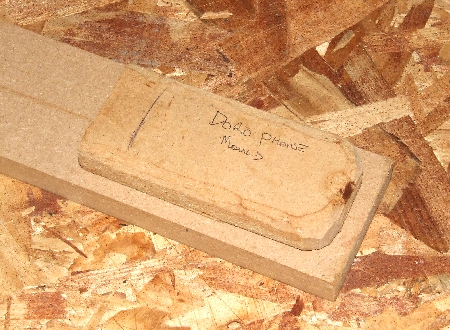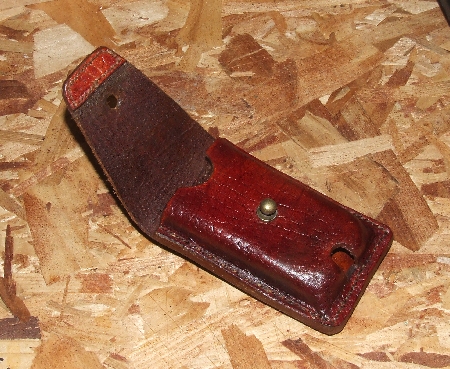-
Posts
5,928 -
Joined
Content Type
Profiles
Forums
Events
Blogs
Gallery
Everything posted by fredk
-
How big a round hole does youse need? I bought these; https://www.ebay.co.uk/itm/3pcs-Tool-Leather-Carving-Hole-Craft-Prong-Stitching-Punching-Punches-Tool/283327622505?ssPageName=STRK%3AMEBIDX%3AIT&_trksid=p2057872.m2749.l2649 I bought a set with 4mm spacing and a set with 6mm spacing. They make holes about 1mm diameter, Fine for 1mm thread or round lacing
-
Try this seller; https://www.ebay.co.uk/itm/Leather-Hide-Skin-Black-Leather-Side-3-5mm-Drum-Dyed-with-a-print-superb/254055721711?hash=item3b26e6aaef:g:CYkAAOSwEA9a~YbP:rk:23:pf:0 I got some thin leather off him last November. It was far better than what he said it was and delivery to me was only 3 days
-
This is the MDF buck I made recently for to wet mould a holster case for my new mobile [aka cell] phone. Its not even neatly carved and not sealed. The leather was bulldog clamped to the base part. The finished holster case;
-
If its anything similar to stuff I was given about 20 years ago; its reconstituted compressed card spray coated with a PVC liquid. A factory in Belfast which made similar closed down about 20 years ago and I was given a van load of belts. They were all marked 'Genuine Leather'. I used a load on toy shields then had the remainder burnt on a bonfire
-
I use MDF board. Its easy to carve with a heavy duty craft knife and rasps. Layers of thin MDF can be built up using just PVA glue. The 'frame' plank is not necessary. On some bags, I mark roughly where the sewing line will be then staple the wet leather to the base, the holes made by the staples are taken up in the holes for sewing. On small bags I use bulldog clamps and lolly sticks to hold the leather in place. With one set of pouches I had to do the leather was wrapped round to the back of the pouch and stapled to the MDF block - the sewing on these was to be hidden at the back, not visible on the front sides and bottom. MDF has no grain to worry about, is cheap and often odd sized off cuts can be obtained at DIY or builders stores or even from building sites.
-
I went to your link. Shop around for a better price. I recently bought one of these from a Chinese seller on ebay. It cost me £26 including delivery charges [about $33 maybe?] I've not used mine yet. It needs very careful setting up, but once set up it apparently will do a grand job - according to other users on this forum Edit; Heres a link to one at £21 [about $27?] https://www.ebay.co.uk/itm/Metal-Leather-Splitter-Rollers-Device-Edge-Skiver-Paring-Cutter-Craft-DIY-Tool-/303030069152?hash=item468dffe7a0
-

This forum really need to have a faster speed
fredk replied to chrisash's topic in Feedback and Suggestions
I found that in my case it was my browser [Firefox] it doesn't happen on Chrome -
On all belts I make, if I use rivets I use at least 4 and often 6. Two up by the buckle, and two each side of the strap keeper. If the buckle has a built in keeper then only 4 rivets, two by the buckle and two at the end of the strip of leather folded over
-

This forum really need to have a faster speed
fredk replied to chrisash's topic in Feedback and Suggestions
No problem at my end. Changing pages is as fast as turning a page in a book. Refreshing a page is almost instant -

When the hole on the back plate is bigger than the rivet
fredk replied to scrapyarddog's topic in How Do I Do That?
Use a ready-rivet? Post diameter is usually 1/8" [about 3mm] and vary in length and can be cut shorter if necessary. Head diameter from about 4mm upwards. Looks like a double-head rivet of 8mm diameter heads would do the job. -
1. dampen your leather, not sodding wet, but wet like you are going to tool it. This will help the dye spread thru the leather 2. Dipping doesn't need a big tank; here's a method I use for long straps, its based on how I used to develop films in the field. Put gloves on, put thinned dye into a jug or tray. Dip one end of dampened strap into dye, pullout by pulling the length of strap thru the dye in the jug/tray. Holding each end of the strap pull it back and forth thru the dye, making sure the ends get into the dye as well. Do not allow any part of the strap to remain in the dye any longer than any other part. Work it back and forth steadily for a short time then hang up to dry. There will be some dye running down the strap; form your first two fingers into a V and run them down the strap, one finger front and one back of the strap, wearing rubber gloves this action will squeegie the excess dye to the bottom of the hanging leather quickly, not allowing it to dry in streaks down the length [although, allowing that leads to interesting patterns] 3. for large flat areas consider using a spray brush to spray the dye on. I've only just started using this method as I don't make anything very big. It does give a very even finish. I use a spray brush which cost under $20 hth
-
UK company Norsol links: https://www.ebay.co.uk/itm/NORSOL-Leather-colourant-pigment-paint-recolour-dye-Industry-Std-120ml/152663364215?_trkparms=aid%3D555018%26algo%3DPL.SIM%26ao%3D1%26asc%3D20140122125356%26meid%3D02a2aaa912654f6ba5b3ab9ed215a5e4%26pid%3D100005%26rk%3D3%26rkt%3D3%26mehot%3Dpp%26sd%3D113026087360%26itm%3D152663364215&_trksid=p2047675.c100005.m1851 https://www.ebay.co.uk/itm/NORSOL-LEATHER-EDGE-FINISH-DYE-PAINT-COAT-COLOURANT-STAIN-120ML/152729174649?_trkparms=aid%3D555018%26algo%3DPL.SIM%26ao%3D1%26asc%3D20140122125356%26meid%3D7378d0744840477eae9d86605c21d325%26pid%3D100005%26rk%3D1%26rkt%3D6%26mehot%3Dpp%26sd%3D152663364215%26itm%3D152729174649&_trksid=p2047675.c100005.m1851
-
I've had a thunk on this. I'd make a tube shaped bag using belly leather. About 5 inches long. A bag like a bicycle handle-bar bag [see below]. Use a snap at each end of a flap that is the main body. Bring the first bag out under the flap, like a dispenser. The flap can be unsnapped for the bag to be refilled. Attach to the leash using Chicago screws. Place it either near the hand grip, or just above the collar end This sort of design, but using a snap at each end of the flap https://www.leathercraftlibrary.com/product/1968/bicycle-handlebar-bag
-
I found the simplest storage of tools solution was some car mechanics tool drawer units. I have one for 'stamping', one for 'sewing & riveting', one for 'cutting, skiving & punching' and another for extra and odd tools eg spare hammers/mallets. The 'Sewing' drawer unit sits atop a drawer/cupboard wheeled base, it all contains my threads, laces, boxes of ready-rivets. The 'stamping' one also sits on a wheeled unit, it all holds all my letter and fancy stamps except the handled tool stamps, the unit also holds boxes of conchos and bag fittings etc. The 'Cutting' unit sits on the lower shelf of my work bench, as does the spare drawer unit. The handled stamp tools are stored in artists paint-brush box units, afair I think each unit holds 64 stamps up-right. These sit on top my workbench. These paint-brush holders cost me about £2 each hth
-
1. not if the first coats sealed the antique or stain 2. one uses a technique called 'dry brushing' where one just uses a dry brush very lightly, just to disperse the bubbles, nether a loaded brush nor a heavy brushing action
-

Knife Sheath Construction Question
fredk replied to steelhawk's topic in Gun Holsters, Rifle Slings and Knife Sheathes
It looks like the sections with the belt slots are one piece with the rear layer of the sheath -

Thinning glue
fredk replied to bobpringle's topic in Dyes, Antiques, Stains, Glues, Waxes, Finishes and Conditioners.
up to now I've been using Evostik contact in the red tin, I've also used Screwfix' own brand. Neither have brushes** and I dont use them either, I use a wide lolly stick* with the round end cut off. When glueing leather to a board for a game board I pour some glue on the board and spread it around with the stick. Being heated it flows better but also starts to 'set' faster - faster than normal but not too rapidly ** the Screwfix one might have had a brush in the lid, but I would have got rid of it * wide lolly sticks, cost about £2 for 50. use multiple times; just cut off the gluey bit and reuse, about 4 times Now, note, heating the glue will make it flow better, its still thick, just not like molasses, more like honey once I forgot to pop the lid; it blew off with the sound like a gunshot - scared the bejayzus out of me so it did -

Thinning glue
fredk replied to bobpringle's topic in Dyes, Antiques, Stains, Glues, Waxes, Finishes and Conditioners.
dunno, I just place the tin in very hot water. pop the lid open first or it blow off. be careful not to get water into the tin. then I just leave it to warm up whilst i sort things out ready for glueing, tidying the work space [yeah, right] so its maybe 5 to 10 minutes for a full-ish 250ml tin -

Thinning glue
fredk replied to bobpringle's topic in Dyes, Antiques, Stains, Glues, Waxes, Finishes and Conditioners.
I use regular contact adhesive. I find that it flows better after the tin is heated in jug of hot water -

Tape measure holder "help please"
fredk replied to Pledgedpatriot's topic in Leatherwork Conversation
Are these the same as what you are looking for? https://www.holstersmith.com/vcom/mountings-belt-loops-canted-c-547_632.html -
It sounds like you are using it neat and the two coats are sufficient. The surface is rejecting the third coat because it is sufficiently sealed and there is no room for it to soak in. The third coat is pooling and drying by evaporation. I find some leathers will just keep soaking up resolene and some are sealed after just a couple of coats. I dilute my res 1:1 with water and dip, spray or brush/sponge it on If you really need that third coat, apply the res and if it starts pooling just keep sponging or brushing it over as it dries
-
Does the leash attach to a body harness or choke collar? 1. If it attaches to a body harness I would make a small bag, about 6" x 6", out of soft belly leather or upholstery type leather. Attach it to the body harness with Chicago screws. 2. If it has to go on the leash I would sew up a tube shaped bag, again using upholstery leather or soft belly leather. A tube about 8" long x 3" diameter, with end opening and flap. Attach along its length using Chicago screws 1. 6 x 6 bag along the shape of this one from Tandy https://www.tandyleather.eu/en/product/bike-bag-kit Construction can be as simple or as detailed as you are content to do
-
That there would be quick. I have some projects I started in '05 - thats 2005, not 1805! [or is it? ] I think I even have some from '02. Anyone who knows me knows that they'll be done in time for Easter/Summer/Thanks Giving/Christmas - but I never tell them what year! My 2019 New Year Resolution is the same as it was for '18, '17, '16. . . its to not make any New Year Resolutions!!
-
N.I. is a very wet place. I rent a half of a 40footer container for storage. The container is bone dry [almost], no condensation nor leaks. I've stored my excess leather, both chrome and veg tan in it for several years now. There has been no problem. I store the leather in rolls on open shelves of shelving units. They get a bit of air round them but not a breeze




